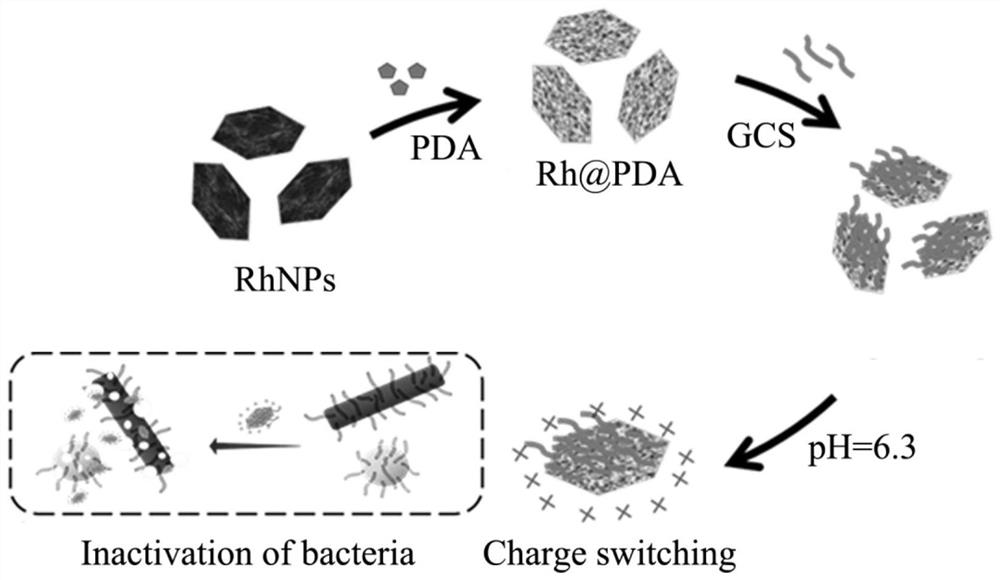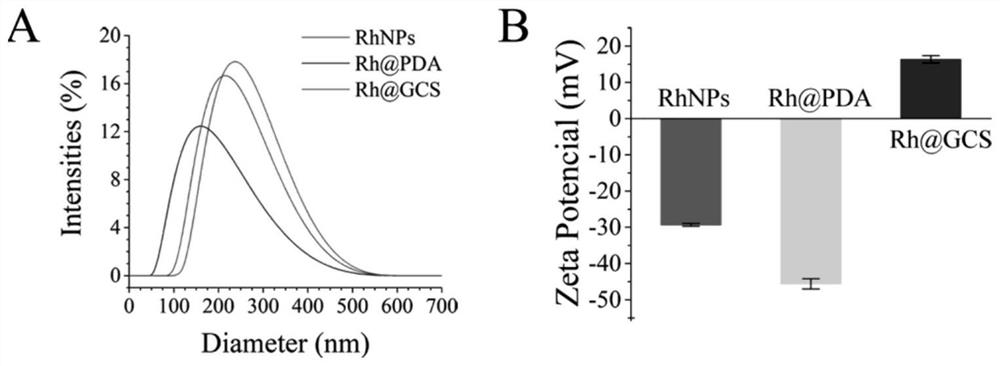Chitosan nano rhodium material and application thereof
A chitosan nano and nano rhodium technology, applied in the field of biomedicine, can solve the problems of high mortality, toxic side effects, and high cost of drug-resistant bacterial infection, and achieve increased biocompatibility, high affinity, and huge application potential. Effect
- Summary
- Abstract
- Description
- Claims
- Application Information
AI Technical Summary
Problems solved by technology
Method used
Image
Examples
Embodiment 1
[0049] The preparation of embodiment 1 chitosan nano-rhodium comprises the following steps:
[0050] 1. Synthesis of nano-silver triangles
[0051] (1) Add 250μL of 10mM AgNO to a 50mL glass bottle 3 , 300 μL 30mM sodium citrate dihydrate (sodium citrate), 1.5mL 3.5mM PVP, 24.75mL deionized water and stir well;
[0052] (2) Add 60 μL of hydrogen peroxide (30%) to (1) under magnetic stirring at 300 rpm and incubate for 3 minutes;
[0053] (3) Add 250 μL of 100 mM sodium borohydride solution to (2) and incubate for 3 hours, the color changes from transparent to light yellow, dark yellow, orange, and finally blue;
[0054] (4) Prepare growth solution: add 20mL 1mM AgNO3 to a 25mL round bottom flask; 0.125mL 100mM citric acid, 10μL 75mM sodium citrate dihydrate;
[0055] (5) Add 13 mL of growth solution to (3) at 0.2 mL / s, and the color of the solution turns dark blue. After reacting for 10 minutes, measure the ultraviolet characterization.
[0056] Two, the synthesis of nano...
Embodiment 2
[0073] The antibacterial function of embodiment 2 nanometer rhodium
[0074] The bacteria used in the antibacterial experiment were methicillin-resistant Staphylococcus aureus (MRSA), and the experimental process was as follows:
[0075] (1) Nano-rhodium antibacterial experiment:
[0076] ① Dilute 1.6 equivalents of nano-rhodium gradients with the LB solution of MRSA (original OD 600 =0.5) 1:1 mixing;
[0077] ②Check OD every hour 600 Value, recorded for 12 hours.
[0078] Such as Figure 4 Shown in A, when the concentration of nanometer rhodium is greater than or equal to 0.4 equivalent, there is better antibacterial effect;
[0079] (2) Nano-rhodium sterilization experiment
[0080] ① 0.4 equivalent of nano-rhodium and MRSA (1 × 10 7 CFU) in vitro for 2 hours at 37°C;
[0081] ② Gradiently dilute the ① incubation solution by 10 4 times, take 100 microliters of dilutions in each order of magnitude to coat the plate, and incubate at 37°C for 24 h;
[0082] ③ Take eac...
Embodiment 3
[0084] Embodiment 3 chitosan nano-rhodium is to bacterial affinity under different pH
[0085] The pH value of the microenvironment at the site of bacterial infection is slightly decreased (pH 6.3) due to the influence of bacterial metabolites.
[0086] GCS is a water-soluble biopolymer with a pH-responsive charge. The positive charge value of chitosan nano-rhodium increases with the decrease of pH, which means that chitosan nano-rhodium can increase its positive charge in a slightly acidic environment. Improves affinity for negatively charged bacteria. When MRSA (drug-resistant Gram-positive bacteria) and Escherichia coli (Gram-negative bacteria) were incubated with chitosan nano-rhodium under the condition of pH 6.3, the negative charge on the surface of the bacteria was converted into a positive charge ( Figure 5 A), shows that chitosan nano-rhodium can adhere well on the bacterial surface and has a high affinity. Further, bacteria coating experiments confirmed that chit...
PUM
| Property | Measurement | Unit |
|---|---|---|
| Hydrated particle size | aaaaa | aaaaa |
Abstract
Description
Claims
Application Information
 Login to View More
Login to View More - R&D
- Intellectual Property
- Life Sciences
- Materials
- Tech Scout
- Unparalleled Data Quality
- Higher Quality Content
- 60% Fewer Hallucinations
Browse by: Latest US Patents, China's latest patents, Technical Efficacy Thesaurus, Application Domain, Technology Topic, Popular Technical Reports.
© 2025 PatSnap. All rights reserved.Legal|Privacy policy|Modern Slavery Act Transparency Statement|Sitemap|About US| Contact US: help@patsnap.com



